History of the emergence and spread of carrots. Carrot is the most ancient plant. People began to grow it more than 4 thousand years ago in Southwest Asia. First as a medicinal plant, and then as a food and fodder plant. The ancient Greeks and ancient Romans called carrots “daucis” and “carota.” These nicknames became botanical names for the crop.
The Mediterranean coast is considered the home of orange carrots and Afghanistan is considered the home of yellow and white carrots.
In the fourteenth century, carrots appeared in France, Germany and the Netherlands. A favorite holiday dish of carrots was at the court of Emperor Charlemagne. There appeared sauces made from carrots, which even today are a delicacy among the Germans and the French.
At this time, carrots began to be grown very widely in Europe. The first was purple in color with a bitter taste. But over time, varieties with a sweet taste and not much of a tough root were bred.
In the first century AD red varieties of carrots appeared, and by the twelfth century yellow and white varieties appeared. In the 17th century, orange-colored carrots were bred in Holland. In the Far East carrots are blood-red in color, there are varieties of purple. In the Japanese islands grow carrots up to 1 m long, and in forage varieties have a root crop up to 30 cm in diameter.
In those days, carrots were eaten with vinegar, salt, olive oil, eaten raw instead of bread.
Today, carrots of various shapes, colors and varieties are grown on every continent except Antarctica. Many varieties have been bred: white, yellow, pink, orange, bright red, purple and even black-purple carrots.

Carrots are part of the table root vegetable group. It tends to form fleshy, juicy, thickened roots. The productive organ is a root vegetable.
Useful Properties of Carrots
Carrots are a source of valuable nutrients.
Carrots contain the following components:
1. Carotene. In the body it is converted into vitamin A. Contributes to the normal functioning of epithelial cells, normalizes reproductive function and vision. The red color of carrots depends on the presence of beta-carotene (provitamin A). If it is a lot – carrots brighter and healthier. Beta-carotene has strong antioxidant and immune-stimulating properties.
2. Biotin. Important vitamin for growth. It is also important for cell growth and renewal. Participates in the metabolism of amino acids and proteins.
3. Pantothenic and folic acids. Have anti-anemic and anti-dermatitis properties.
4. Vitamins C, B1, B2, B3, E, K, and PP.
5. Phytoncides. Natural antibiotics. Stops the growth and development of pathogenic bacteria.
6. Essential oils. Have antioxidant and antitumor activity.
7. Minerals: potassium, magnesium, zinc, calcium and iodine.
8. Flavonoids. One important flavonoid, daucarin, is essential for chronic coronary artery disease, atherosclerosis and angina pectoris. Only plants can produce these substances, they do not accumulate in the body, so they must be consumed with food daily.
And this is only a small part of all the useful elements in carrots. All varieties of carrots are rich in fiber, sugars, protein, and contain fat.
Calories and nutritional value of carrots
The caloric value of a carrot is 35 kcal.
Nutritional value of carrots: protein – 1,3 g, fat – 0,1 g, carbohydrates – 6,9 g
Influence of Carrots on the Human Body
Carrots are used in medicine to treat cardiovascular and intestinal diseases, anemia, polyarthritis. Carrot juice – the first remedy in the treatment of avitaminosis. Phytoncides – kill germs, so carrots – an effective remedy for colds and tonsillitis.
Carrots (vitamin A) strengthens the retina. Carrots are very useful for children and young girls. Its components keep the skin and mucous membranes in a healthy state. Scientists have proved that raw carrots can be used to treat malignant tumors. It has a diuretic and laxative effect.

The use of carrots has a positive effect on the male reproductive system. It reduces blood sugar levels. Restores the function of the endocrine system. Accelerates the removal of harmful cholesterol. Exceeding its permissible value has a negative effect on potency.
Carrots prevent the formation of tartar. Contributes to the strengthening of the gums. Reduces blood pressure. Does not allow the leaching of calcium from the bones, it is useful for anemia.
In modern nutrition the vegetable is valued for its nutritional properties – low calorie and fiber content.
Carrots can be allergenic (due to the proteins it contains). Allergies can manifest themselves as disorders of the digestive and respiratory systems, skin reactions (dermatitis, itching).
Types and Varieties of Carrots
There are two kinds of carrots:
- Wild carrot (lat. Daucus carota)
It grows in natural conditions. The root of the plant is fleshy, white or yellowish in color. Not suitable for eating. The stem grows to a height of 0.25-100 cm. Its upper part is branched, and its leaves are triangular or ovoid in shape and strongly rugged in appearance. Carrot leaves can be up to 20 cm long and up to 5 cm wide. The flowering period lasts from June to July.
- Sown carrots (lat. Daucuscarota sativus)
Cultivated by humans. A subspecies of the wild carrot. A variety of forage and table varieties.
Forage carrots
Grown for use in cattle and small ruminants. The root vegetable is shaped like a cylinder or elongated cone. Its length varies from 30 to 50 cm. Some carrot varieties may have a cylindrical shape with a rounded end.
Varieties of this type of carrot differ in color and shape of the root crop. They can be white, yellow and red.
Table carrots
Varieties of this type of carrot are grown for eating.
They are divided by ripening time into:
- early-ripening (early),
- medium-ripening,
- late-ripening (late).
Early (early-ripening) carrots
The ripening period of carrots does not exceed 100 days. Root crops are suitable for consumption both raw and for thermal processing. Not suitable for long-term storage.
Varieties of early carrots in color come in dark orange, purple root vegetables, round, cylinder or cone shape. They are up to 25 cm long and 3-6 cm or 15-30 mm in diameter. Flesh: juicy, tender, with a sweet taste, orange in color.
Medium-ripening carrots
It takes up to 120 days from the time the tops appear on the surface until ripening. Root vegetables are used in food after cooking. Can be stored for long periods.
Varieties of medium-ripening carrots have a flesh color of orange, red-orange. It tastes juicy and sweet. The root crop is cone-shaped, cylinder-shaped with a blunted tip. Carrots in these varieties are from 13-25 cm long and weigh 130-200 g.
Late maturing carrots
The ripening period of this type of carrot lasts up to 140 days. Late carrots have good taste qualities. They can be used raw and after heat treatment. Carrots have a long shelf life, almost to a new harvest.
Varieties of such carrots with large root vegetables. Shaped like a cylinder or cone with a blunted tip. The flesh is dense, juicy, orange in color. Carrots are 20-30 cm long and weigh 200 g.
Mini carrots are a very common product in the United States and Europe. They are added to salads, stews or eaten between meals.
Carrot juice is the most popular of the vegetable juices. Its sweet taste allows it to be used both pure and in mixtures with other vegetable juices.

How to Choose Carrots?
- Choose carrots that are firm, smooth, properly shaped and fresh in appearance.
- Do not buy carrots with very thick tops – they will have too large a core and can be woody.
- When choosing carrots, look for small bright orange fruits. The most “vitaminized” carrots weigh about 150 grams. The larger the root vegetable, the more it absorbs nitrates.
- It is best to choose bright orange carrots. It is the color that determines its usefulness. The orange color is characterized by carotene (vitamin A). The brighter the color, the more carotene it has.
- Carrots should not be soft. Buy hard carrots without spots or cracks. These mean that the carrot has a spoiled middle.
- Carrots should not have any growths on them. The surface should be smooth. Warts on carrots indicate a disease in the vegetable, or the presence of nitrates in the carrots.
- A good carrot has a bright green color in the area between the tops and the fruit.
- The juiciest carrots are thick, short, dark orange. They are pickled, put in salads and vegetable stews, eaten raw and juiced. The light orange root vegetables with long tails have much less juice. They are more suitable for carrot cutlets and casseroles, so that they hold their shape better.
- You can tell the juiciness of carrots by pressing the surface with your fingernail. If there is a lot of juice in the root, it will stand out.
How Do You Know if a Carrot is Spoiled?
- The presence of damage and severe deformation of the rootcrop.
- Carrots with dark spots or dots, which indicates the beginning of rotting.
- Vegetables with green spots – indicate prolonged storage in the sun or immaturity.
- Carrots with sprouts – are overripe and endowed with less flavor.
- Roots with a soft surface and the presence of numerous cracks.
- A product with a wet surface, indicates spoilage or over-treatment with chemicals.
- Carrots with thin black stripes. These appear due to pest infestation.
- Large green area between the tops and root (more than 1 cm), indicates that the vegetable is overripe.
- Sluggish carrots – there is no juice and taste.
- If after washing such vegetables, a film of white-gray color appeared on the surface – the carrots were silvered, caused by damage to the skin during harvesting, transportation or storage.
Slicing Options for Carrots

Straw
- Slice by hand or with a vegetable slicer.
- When slicing carrots by hand you cut them into thin slices and shred them in julienne.
- Used for marinades, borsches, noodle soups, rassolniki, carrot cutlets.
Bars
- Cut raw carrots crosswise into cylinders 3.5-4 cm long.
- Then cut them into 0.5 cm thick slices and cut into slices.
- Use in pasta soup, broth with vegetables and for poaching.
Cubes
- You cut the carrots lengthwise into long bars.
- Now cut them crosswise into cubes.
The cubes come in medium, small and crumbly sizes.
- Medium dice you cut raw carrots for poaching, stewing.
- Small cubes and crumbles of raw carrots are used to make soups.
Big slices
- Cut carrots crosswise into cylinders 4 cm high.
- Cut them in half lengthwise and radius each half into slices.
- Use for poaching, stews, fresh cabbage soup, beef stew.
Circles

- Slice carrots of equal diameter (up to 3 cm) into 1 mm thick slices.
- Use raw slices for soup, cooked ones for cold dishes.
Small slices
- You cut the carrots lengthwise into two or four pieces.
- Then you slice them crosswise into 1-2 mm thick slices.
- Raw slices are used for making borsches, cooked carrot slices for salads and vinaigrettes.
To cut carrots into more complex shapes the method of carving is used.
Carrots of equal diameter are aligned with a slice around the circumference. Then carve with a root knife (kitchen knife – for peeling and slicing root crops) or a special knife.
Sprockets
- Carve carrots crosswise into 1 mm thick pieces.
- Use to decorate cold dishes.
Scallops
- Slice a carrot lengthways in half.
- Then slice 1 mm thick at an angle.
- Use to decorate cold dishes.
Scallions and nuts
- Slice carrots into balls of different size with special notches or grind by hand.
- Use in boiled form as a garnish to cold dishes.
How to Store Carrots? Do I Need to Wash Carrots Before Storing Them?
Wash or not – a controversial question. Everyone chooses for himself. Here are the positive aspects of washing carrots:
- all mechanical damage or lack thereof is immediately visible;
- traces of disease and rot are visible;
- harmful microorganisms are removed;
- easier to handle during storage
Negatives: Washed carrots are more demanding on storage conditions. They need to be dried longer before being sent to long-term storage.
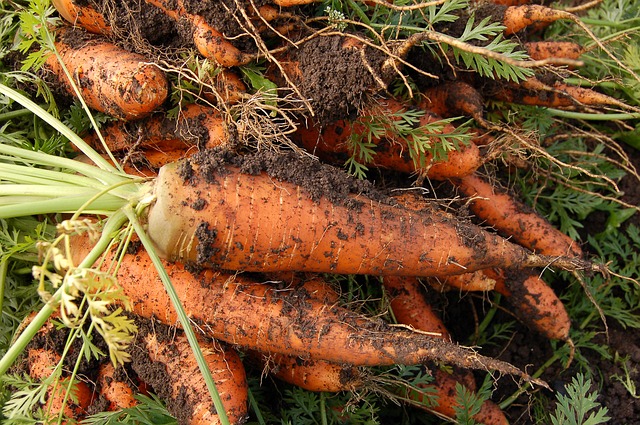
Storing carrots in the refrigerator
- Rinse the carrots well and dry them before storing. This way, mold will not form during storage.
- Store carrots in the refrigerator, better away from other fruits, they can contribute to the rapid deterioration of carrots.
- You can not wash the carrots before storage, but you need to dry them a little (a few hours will suffice).
- Place the vegetables in bags, let the air out and tie tightly.
- Shelf life of carrots in the refrigerator is 30-40 days.
- Dry and clean carrots can be put in plastic bags, no more than 6-7 pieces per bag.
- Make a few holes in them for air circulation.
- You can wrap each carrot in plastic wrap and store it that way.
- The best place in the refrigerator for carrots is the middle or bottom shelf, or a vegetable drawer.
Modern refrigerators have different compartments: for prepared foods, a compartment for fresh raw vegetables and a freezer compartment.
Temperatures for storing carrots in the refrigerator:
- In the main compartment at +2°C (35.6 °F) to +6°C (42.8 °F) ;
- In the “fresh compartment” at 0°C (32°F) to +3°C (37.4°F).
- In the freezer compartment at -8°C (17.6°F) to -23°C (-9.4°F).
Peeled carrots should not be opened in the refrigerator for storage. This way they quickly become weathered and lose moisture. If you immerse such carrots in water, you can keep them for 3-4 days, and if you change the water – up to 7 days.
Grated carrots should be stored in the main compartment of the refrigerator in a container, glass jar with a lid, or in a plastic bag. Without sub-freezing, the shelf life will not be long. Use grated carrots in food for 10-12 days.
Storing carrots at room temperature
- Find a cool and dry place, protected from sunlight.
- Store carrots at home in crates or bags.
- Store carrots at room temperature for a maximum of 2 months.
- If you store carrots at room temperature – once every 1-2 weeks, check the carrots for spoilage. Remove them from healthy vegetables. This will increase the shelf life slightly.
Storing carrots in the freezer
To preserve carrots for a long time, you can freeze them. But not all carrots can be frozen. Sluggish, tough, infected or dry carrots are not suitable for this purpose. It is best to use fresh and sweet vegetables.
- Before freezing, peel the carrots, rinse and dry them a bit.
- Shred them if you need to.
- Then put them in airtight containers or plastic bags, letting the air out of them.
- Then put them in the freezer.
- Store carrots in the freezer for 9-12 months.
When storing carrots in the freezer, you should pay attention to the appearance of condensation inside the plastic or polyethylene packages. These droplets indicate the concentration of carbon dioxide inside the container. If you find condensation – the carrots should be removed, dried and packed again.
Freezing carrots
To prepare carrots for freezing, you need to blanch them. This is necessary to protect against the development of disease, mold, rotting, changes in taste, hue and other negative effects. This process also helps preserve the smell and color of the vegetable.
After blanching the carrots, continue preparation. To ensure that the rootcrops and slices do not freeze to each other – on a wooden board in a single layer, spread the slices, without touching each other. After 2-3 hours of freezing, spread the product in containers for freezing.
You can freeze carrots can also use this option.
- Pre-clean and wash the carrots.
- Grind it with a blender or mincing machine, you can grate it on a fine grater.
- Put them in a mold for ice.
- Add some water or sunflower oil and put them in the freezer.
- In 8-10 hours you can put the frozen cubes into a bag or leave them in their shape.
- Such carrots will be a semi-finished product for dressing ready meals.
3 Ways to Cook Carrots
Carrots are one of the most vitamin-rich vegetables. During cooking, some of the useful substances are lost. To minimize the loss of vitamins – do not cook it in an open pot. A lid will help preserve the flavor and aroma of the vegetable, and make the dish more useful.
Peeling carrots removes a lot of the vitamins that are in the skin. So, instead of cutting off the skin with a knife, rub the carrots with a vegetable brush.
Only 3 percent of beta-carotene is absorbed from raw carrots. To increase the absorption of fat-soluble vitamins recommended heat treatment of carrots with fats: fry, stew, add to stews, sauces.
Blanching carrots
Carrots (young, cut into pieces): 2-4 minutes.
Carrots (whole): 20 minutes.
- Boil a pot of water.
- You can salt the hot water.
- Prepare a bowl with very cold water, throw a few ice cubes in it.
- Prepare the carrots: wash, peel and slice (as you need).
- Put the prepared pieces in a pot of boiling water for the desired time (depends on the type of carrots).
- After this time, take it out and immediately transfer it to a bowl of ice water.
- Wait for it to cool. This will take a few minutes – cool for about as long (or a little less) as the blanching itself lasted.
- Remove the carrots and pat them dry.
Boiled carrots
Wash the carrots under warm water.
- Put the carrots in a pan (if they don’t fit, cut the carrots in half).
- Cover with water until the carrots are completely covered.
- Put the pot on the fire and cover.
- Boil the carrots for 20-30 minutes, depending on size and variety.
- Check carrots for readiness – cooked carrots can be pierced easily with a fork.
- Drain the water, put the carrots in a colander and cool slightly.
- Holding the carrot in front of you, peel the skin.
- You can use the peeled boiled carrots for culinary purposes.
Peel carrots – after boiling. This way carrots retain more nutrients, and peeling is faster and easier. Salt carrots after boiling when cooking the final dish.
Sautéing (frying) carrots
- Shred the carrots on a coarse grater or cut into thin slices, cubes. The pieces should not be too large.
- For pasting usually use vegetable oil, but you can use olive oil or butter.
- Heat oil in a frying pan or saucepan over high heat until hot.
- Add the carrots and fry until soft from 5 to 10 minutes.
- Cool and use for cooking.
Carrot Cooking Recipes Ideas
Carrots go well with many products. Use it in salads, soups, drinks, and desserts.
Not many people like carrots. But maybe you can change your opinion about it with interesting culinary ideas.
Carrots are used in many cuisines around the world. In Europe and Asia it is an important element of salads, vegetable stews, broths and soups. Because of its sweet taste, carrots are used in desserts: the Indian dessert of carrots boiled in milk, Jewish tsimmes, English pudding.
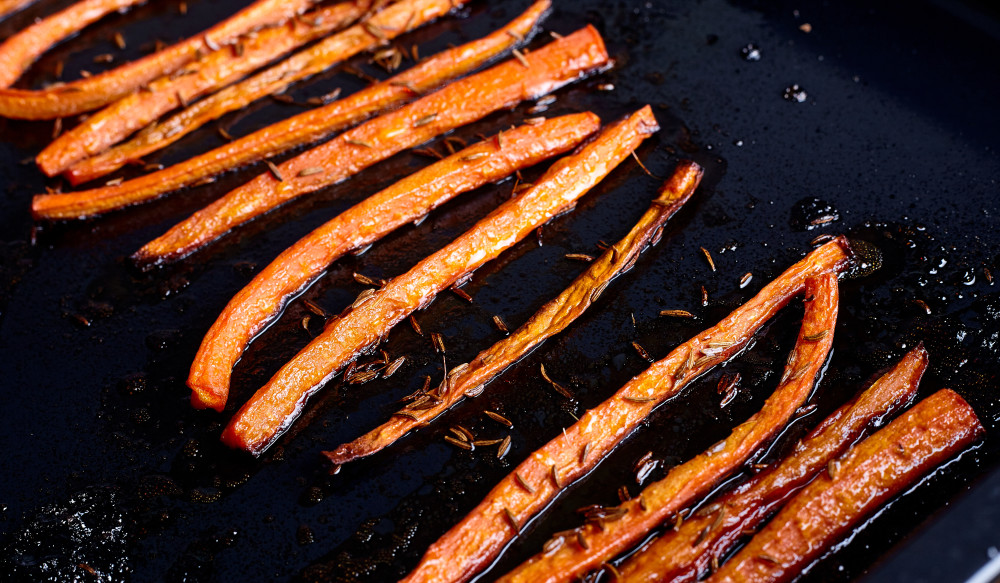
Carrots in this dish are tender and sweet, well baked on the outside and soft inside. Such a dish is suitable for the festive table as an appetizer or as a supplement to vegetable and meat dishes. Serve the dish hot.
2. Carrot cake with mascarpone and lime

Carrots in desserts are no less useful and delicious. It would be hard to even realize that the pie is carrot-based. The tender and moist spongy crust, a beautiful carrot color, is filled with spice flavors and a slight citrus note. This tart tastes amazing.
3. Roasted carrots with mint and tahini sauce

Extremely beautiful and delicious dish. The carrots taste sweet, nutty, creamy, sour and refreshingly minty. You can serve the dish hot or cold, as a salad or as a side dish.

A French dish (there is a region of Crecy in France). And the English traditionally eat this soup on the anniversary of the victory of the Battle of Crécy. A very delicate soup, easy to prepare. The carrots are subtle on the palate.
5. Carrot tahini soup with Zaatar croutons

A light, dietary and vegetarian soup. The crunchy note is added to this dish by the croutons. A very hearty and nutritious soup.
Easy-to-make soup. Will like and surprise you with a flawless bright flavor. Ginger adds spice to the flavor and will warm you up on a cold fall dinner. Add sourness to this dish with a lime slice.
7. Mottled dumplings with potatoes and carrots
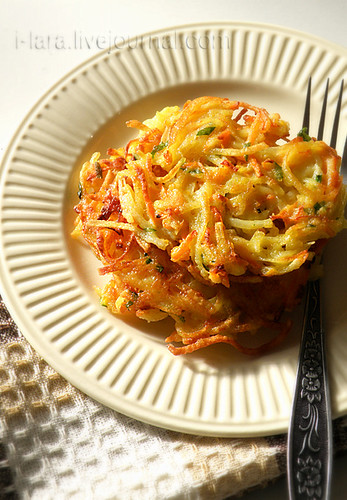
A tasty snack or as a main dish you can apply. Add sour cream to the doughnuts – adds juiciness and tenderness to them. Crispy and soft at the same time, you will definitely like the dreniki.
8. Carrot salad
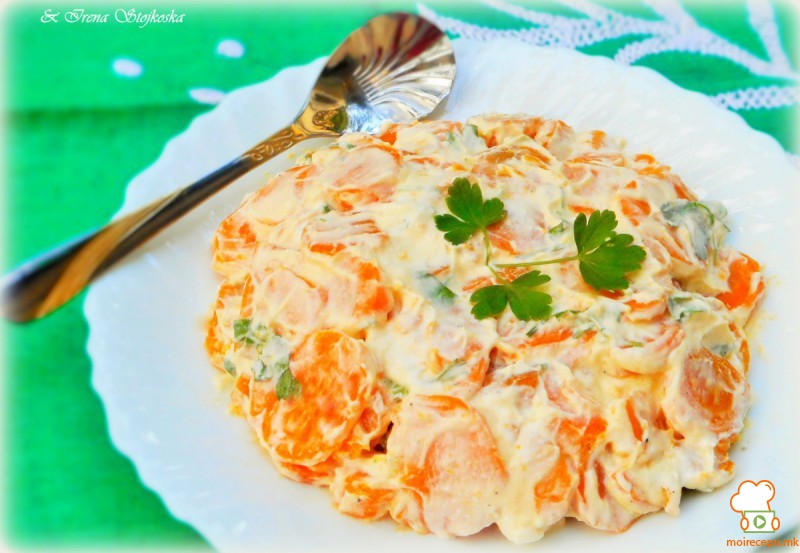
A refreshing and light salad for summertime. You dress it with sour cream or you can use mayonnaise. For a variety you can add mushrooms, cheese.
9. Korean-style carrots at home
Minimum amount of ingredients and maximum flavor. You can add cabbage, hot peppers – for more spiciness and brightness of taste. Then you can use such carrots as an ingredient for different kinds of salads.
10. Salad with Korean carrots and mushrooms

Korean carrots are a popular oriental snack that has become popular in many countries. The salad turns out not only tasty, moderately spicy and refined, but also quite hearty. A great addition to the dish is a sprinkling of sesame seeds. Will make the salad even more delicious and beautiful when served.
11. Carrot salad with nuts and garlic
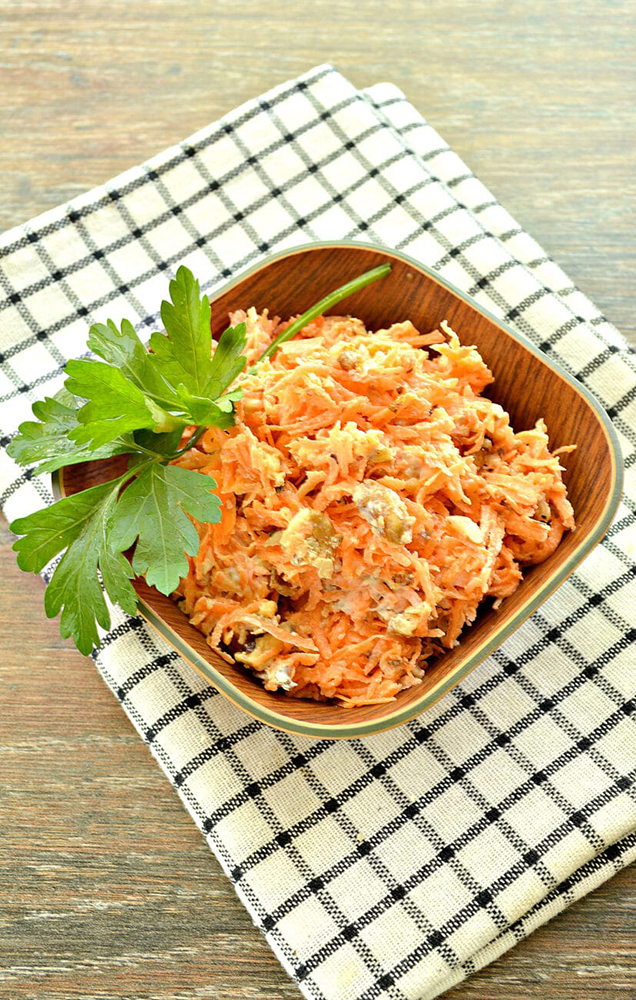
Carrots go great with nuts and garlic. Very quick to make. You only need 10 minutes. And you get a tangy and delicious salad.
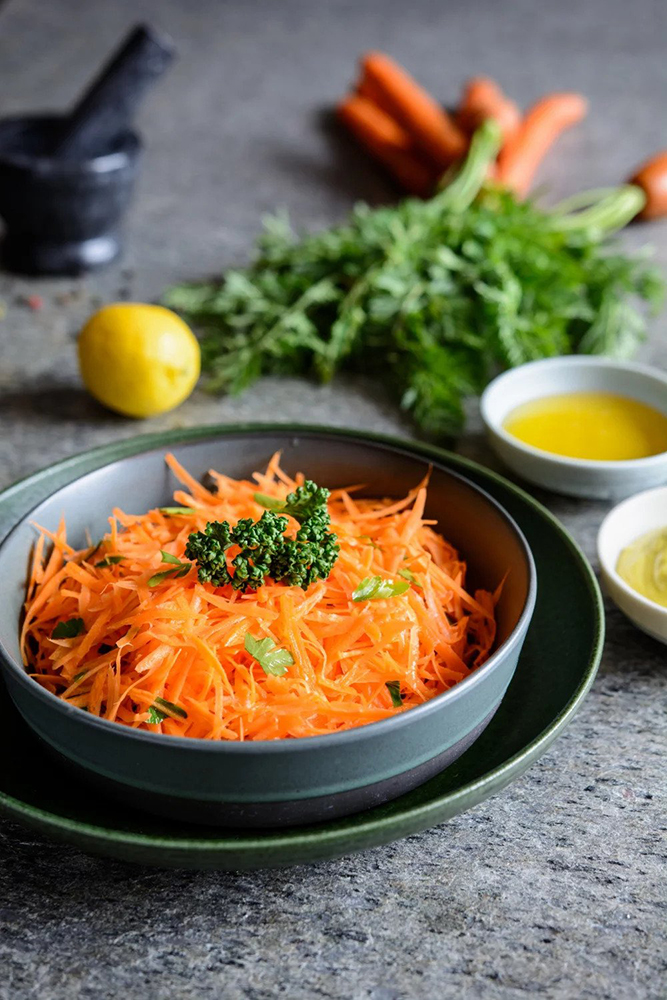
Useful and vitamin salad. For flavor you can add mint leaves. This easy-to-make salad will be a frequent dish on your menu.
13. Baked apple with pineapple and grated carrots

If you love baked apples, this dish will definitely be one of your favorites. An unconventional serving of baked apples in the form of a crockpot. Carrots add sweetness to the apple. Flavorful, with a flavor of pineapple, the dish will surprise any foodie.




